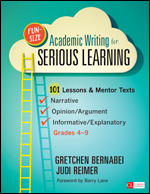Fun-Size Academic Writing for Serious Learning
101 Lessons & Mentor Texts--Narrative, Opinion/Argument, & Informative/Explanatory, Grades 4-9
- Gretchen Bernabei - Consultant, Educator, Trail of Breadcrumbs
- Judi Reimer - Educator, Freelance Writer
Foreword by Barry Lane
Corwin Literacy
English/Language Arts Common Core | Writing (Middle/High School) | Writing (Primary/Elementary)
Supplements
“Here is what I love about this book: It has gobs and gobs of student writing samples with smart and lively explanations of how to use each as the focus of a craft lesson to teach writing. The right models of student writing are the best mentor texts a teacher can find and with this book, you need look no further. . . . Breathe, fellow writing teachers. Much needed and wanted help has arrived.”
“Gretchen Bernabei is a wizard. In this book she provides wonderfully practical help for instruction in narrative, expository, and argumentative writing. And like all her work, it rests on a dynamic sense of ‘structure’. At a time when writing instruction is becoming increasingly formulaic, Gretchen continues to show the wealth of options students can have for developing their ideas and expanding on their experiences.”
“Gretchen Bernabei has done it again--only better. Fun-Size Academic Writing for Serious Learning plops us down in the middle of the disheveled process of writing and gives us concrete ways to navigate through. This book stands apart in two ways. First, it gives us myriad unpublished mentor texts written by students with diverse abilities and backgrounds. Second, its a la carte format makes it a perfect resource from which teachers can cull lessons.”
“Once again, Gretchen Bernabei weaves together masterful, concrete strategies with powerful student examples. Gretchen provides text structures and student models to move authentic writing beyond traditional formulas. This book is a must read/must try for all ELA teachers.”
“The good news is that the book you hold in your hand is a lifeline to real writing instruction. Based on careful observation of wonderfully varied student writing, grades 4-9, and organized around the genres of the Common Core Standards, Fun-Sized Academic Writing is the best book I know for giving students a fun-sized suit that fits their true voices as writers and thinkers.”
